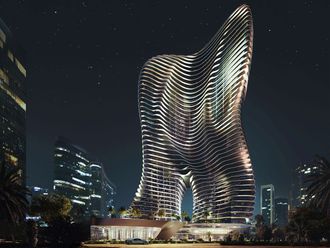In Dubai, there is never a shortage of tenants for super-prime office space. It certainly is the case now with occupancy levels at Grade A addresses operating at near full occupancy and even managing to inch up by 1.3 per cent in the three months to June, according to the latest update from Knight Frank, the consultancy.
Knight Frank defines the prime office nameplates as being some of the high-rises in DIFC, including the Emirates Towers and the vast expanse that is the One Central precinct.
“Demand in these locations remains high due to limited new supply, free zone status, international regulatory standards and the quality of local infrastructure,” states the report. “High occupancy will continue to support rents, which supports our view that prime rents will rise further this year.”
But slightly below the prime scale, the market dynamic is sort of mixed. In these locations — the Downtown and the office towers on Shaikh Zayed Road — rents have dipped by 2 per cent over the April to June time frame. And on a 12-month basis, the decline has been by 4.4 per cent, according to the consultancy.
“Vacancies in DIFC remain low with DIFC Phase 1 registering vacancy at 1 per cent as at Q2-17 [second quarter of 2017],” the report states. “However even within these prime locations, for periphery offerings [DIFC Phase 2], absorption rates remains low.
“Although, as the master plan is finalised we expect this absorption rate to steadily increase as the ‘core’ expands. This trend maybe further heightened with the move towards mixed-use developments which encourage urban living by linking business, cultural and lifestyle environments.”
But at a broader level, the top end of the office market in Dubai is doing just fine, and markedly so in comparison to how similar quality properties in Abu Dhabi are faring in the recent past. That demand patterns are consistent will be the biggest takeaway for Dubai’s office landlords, and especially for those who can promise potential tenants a certain degree of quality and other trappings tenants typically demand.
But moving beyond prime and Grade A, it becomes slightly more difficult to match landlord and tenant expectations.
“On average, rents fell 7.5 per cent in the city-wide market in the year to June and 0.7 per cent over the three months ending June,” the report finds. “In Business Bay, where supply continues to rise, there is a downward trend in rental rates which has led to increased demand for space in strata-titled buildings.
“For single ownership buildings in Business Bay we are witnessing increasing demand which has helped underpin price stability over the last year.”
New supply should keep rents in check
With sizeable new supply, especially of Grade A premises, coming through, this is likely to “offset any potential upside in rental values”, the report notes.
“City-wide, we expect pockets of outperformance to be sustained due to limited availability of good quality stock in preferred locations. However, on average rental value are expected to continue to fall marginally.”











